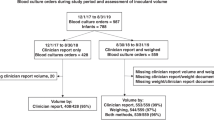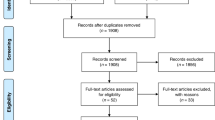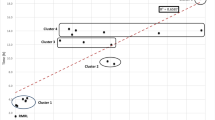Abstract
Background:
The optimal number of blood cultures needed to document sepsis in an ill neonate has undergone little critical evaluation. Multiple site cultures may improve pathogen detection if intermittent bacteremia occurs, or if a low density of bacteria is present in the blood. We hypothesized, however, that bacterial clearance is slower and bacteremia more continuous in septic neonates, so that a single site blood culture should be sufficient to accurately document true septicemia.
Objective:
To determine the need for multiple site blood cultures in the evaluation of neonates for sepsis.
Design/Methods:
Clinical data were prospectively collected for 216 neonates who had 269 pairs of blood cultures taken from two different peripheral sites for the evaluation of possible sepsis. A minimum of 1 ml of blood was obtained from the two peripheral sites within 15–30 min of each other. Based on prior retrospective data, we determined that 203 infants would need to have two site blood cultures to demonstrate a significant improvement in pathogen detection at an alpha of 0.05 and a beta of 0.20 (80%) power.
Results:
A total of 186 culture pairs were taken for evaluation of early-onset sepsis in 186 neonates, while 83 pairs were drawn for evaluation of late-onset sepsis in 43 neonates. In all, 21 neonates from the late-onset group were evaluated more than once, and 12 neonates were evaluated for both early- and late-onset sepsis. In all, 20 (9.2%) of 216 neonates had 22 episodes of culture-proven sepsis at a median age of 18 days. All neonates with positive cultures had the same organism with a similar sensitivity pattern obtained from the two different peripheral sites. The other 196 study neonates had negative blood cultures from both sites. The single episode of early-onset sepsis was caused by Listeria monocytogenes, while all remaining episodes were late-onset with the following organisms: Staphylococcus epidermidis (7), methicillin-resistant Staphylococcus aureus (MRSA) (3), combined MRSA and Candida albicans (2), Candida albicans alone (2), late-onset Group B β-hemolytic Streptococcus (GBS) (2), Klebsiella pneumoniae (2), Enterococcus fecalis (1), Escherichia coli (1), and Serratia marcescens (1). Since no infant grew organisms from only one of the two sites, the data indicate that the diagnosis of sepsis would have been made correctly in all infants with a single site culture.
Conclusions:
Two site blood cultures for the initial evaluation of neonatal sepsis do not have a better yield in pathogen detection. Sepsis in neonates can be detected with no loss of accuracy with a single site blood culture with blood volume of ⩾1 ml.
This is a preview of subscription content, access via your institution
Access options
Subscribe to this journal
Receive 12 print issues and online access
$259.00 per year
only $21.58 per issue
Buy this article
- Purchase on Springer Link
- Instant access to full article PDF
Prices may be subject to local taxes which are calculated during checkout

Similar content being viewed by others
References
Klein JO, Marcy SM . Bacterial sepsis and meningitis. In: Remington JS, Klein JO (eds). Infectious diseases of the fetus and newborn infant. 3rd ed. Saunders: Philadelphia; 1990, pp 601–656.
Kovatch AL, Wald ER . Evaluation of the febrile neonate. Semin Perinatol 1985; 9: 12–19.
Wientzen RL, McCracken GH . Pathogenesis and management of neonatal sepsis and meningitis. Curr Prob Pediatr 1977; 8: 1–62.
Wiswell TE, Hachey WE . Multiple site blood cultures in the initial evaluation for neonatal sepsis during the first week of life. Pediatr Infect Dis J 1991; 10 (5): 365–369.
Wilson HD, Eichenwald H . Sepsis neonatorum. Pediatr Clin North Am 1974; 21: 571–581.
Sprunt K . Commentary. In: Gellis SS (ed). 1973 yearbook of pediatrics. Year Book Medical Publishers: Chicago; 1973, p 15.
Gotoff SP, Behrman RE . Neonatal Septicemia. J Pediatr 1970; 76: 142–153.
Clausen C . Diagnostic bacteriology. In: Wedgwood RJ, Davis SD, Ray CG, Kelly VC (eds). Infections in children. Harper & Row: Philadelphia; 1982, pp 502–505.
Rinaldi MG . Clinical specimens for microbiologic examinations. In: Hoeprich PD (ed). Infectious Diseases: A Modern Treatise of Infectious Processes. Harper & Row: Philadelphia; 1983, pp 138–141.
Ronald AR, Hoban D . Microbiology for clinician. In: Mandell LA, Ralph ED (eds). Essentials of Infectious Diseases. Blackwell: Boston; 1985, pp 3–12.
Steele RW . Procedures. In: A Clinical Manual of Pediatric Infectious Disease. Appleton-Century-Crofts: Norwalk, CT; 1986, pp 113–125.
Malathi I, Millar MR, Leeming JP, Hedges A, Marlow N . Skin disinfection in preterm infants. Arch Dis Child 1993; 69 (3): 312–316.
Struthers S, Underhill H, Albersheim S, Greenberg D, Dobson S . A comparison of two versus one blood culture in the diagnosis and treatment of coagulase-negative staphylococcus in the neonatal intensive care unit. J Perinatol 2002; 22: 547–549.
Philip AGS . The changing face of neonatal infection: experience at a regional medical center. Pediatr Infect Dis J 1994; 13: 1098–1102.
Stoll BJ, Gordon T, Korones SB, Shankaran S, Tyson JE, Bauer CR et al. Late-onset sepsis in very low birth weight neonates: a report from the National Institute of Child Health and Human Development Neonatal Research Network. J Pediatr 1996; 129: 63–71.
Jawaheer G, Neal TJ, Shaw NJ . Blood culture volume and detection of coagulase negative staphylococcal septicaemia in neonates. Arch Dis Child Fetal Neonatal Ed 1997; 76 (1): F57–F58.
Kellogg JA, Manzella JP, Bankert DA . Frequency of low-level bacteremia in children from birth to 15 years of age. J Clin Microbiol 2000; 38: 2181–2185.
Sabui T, Tudehope DI, Tilse M . Clinical significance of quantitative blood cultures in newborn infants. J Paediatr Child Health 1999; 35: 578–581.
Zaidi AK, Knaut AL, Mirrett S et al. Value of routine anaerobic blood cultures for pediatric patients. J Pediatr 1995; 127: 263–268.
Buttery JP . Blood cultures in newborns and children: optimising an everyday test. Arch Dis Child Fetal Neonatal Ed 2002; 87 (1): F25–F28.
Li J, Plorde JJ, Carlson LG . Effects of volume and periodicity on blood cultures. J Clin Microbiol 1994; 32: 2829–2831.
Yagupsky P, Nolte FS . Quantitative aspects of septicemia. Clin Microbiol Rev 1990; 3: 269–279.
Dietzman DE, Fischer MD, Schoenknecht FD . Neonatal Escherichia coli septicemia: bacterial counts in blood. J Pediatr 1974; 85: 128–130.
Phillips SE, Bradley JS . Bacteremia detected by lysis direct plating in a neonatal intensive care unit. J Clin Microbiol 1990; 28: 1–4.
Kellogg JA, Manzella JP, McConville JH . Clinical laboratory comparison of the 10-ml isolator blood culture system with BACTEC radiometric blood culture media. J Clin Microbiol 1984; 20: 618–623.
Philip A . Traditional sepsis workup. In: Neonatal sepsis and meningitis. GK Hall: Boston; 1985, pp 79–97.
Sidebottom DG, Freeman J, Platt R, Epstein MF, Goldmann DA . Fifteen-year experience with bloodstream isolates of coagulase-negative Staphylocci in neonatal intensive care. J Clin Micribiol 1988; 26: 713–718.
Acknowledgements
We acknowledge the valuable contribution of Patricia Mele, NNP and Claudia Herbert, NNP from Division of Neonatology, SUNY-Stony Brook, Stony Brook, NY for assistance in collection of data and the specimens.
Author information
Authors and Affiliations
Corresponding author
Rights and permissions
About this article
Cite this article
Sarkar, S., Bhagat, I., DeCristofaro, J. et al. A study of the role of multiple site blood cultures in the evaluation of neonatal sepsis. J Perinatol 26, 18–22 (2006). https://doi.org/10.1038/sj.jp.7211410
Received:
Revised:
Accepted:
Published:
Issue Date:
DOI: https://doi.org/10.1038/sj.jp.7211410
Keywords
This article is cited by
-
Diagnosis of neonatal sepsis: the past, present and future
Pediatric Research (2022)
-
Sustainable neonatal CLABSI surveillance: consensus towards new criteria in the Netherlands
Antimicrobial Resistance & Infection Control (2021)
-
Prävention von Gefäßkatheter-assoziierten Infektionen bei Früh- und Neugeborenen
Bundesgesundheitsblatt - Gesundheitsforschung - Gesundheitsschutz (2018)
-
Simultaneous two-site blood culture for diagnosis of neonatal sepsis
Indian Pediatrics (2017)
-
Optimizing the Use of Antibacterial Agents in the Neonatal Period
Pediatric Drugs (2016)



